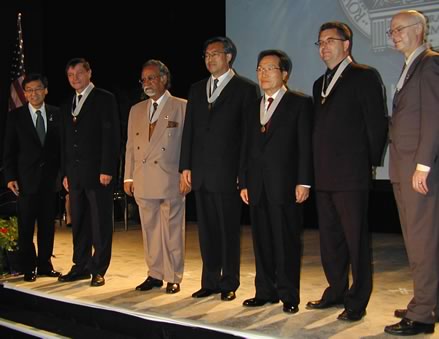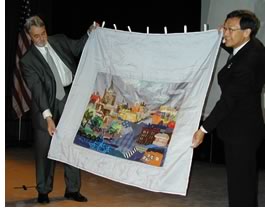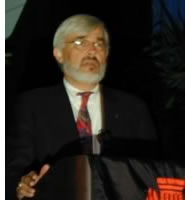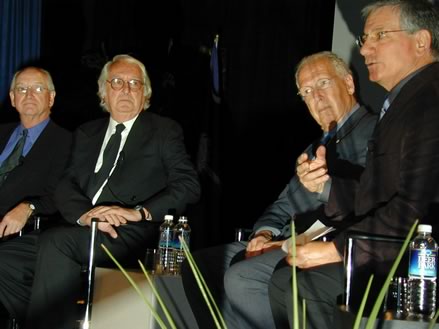
Erickson, Graves, and Meier take on "DesignDesign" theme

Associate Editor
On the final day of AIA Convention 2002, Saturday's general session feted AIA award winners and prompted discussion among three of the profession's most revered architects. AIA national leadership also revealed the theme for next year's convention in San Diego: "Design Matters."

AIA President Gordon Chong opened the final general
session of AIA Convention 2002 by awarding AIA Presidential Medals to
the heads of foreign architect societies:
• Song Chunhua, Hon. AIA (Architectural Society of China)
• Graham Jahn, FRAIA, Hon. AIA (Royal Australian Institute of Architects)
• Juhani Katainen, Hon. AIA (Architects' Council of Europe)
• Il In Hwang, Hon. AIA (Korean Institute of Architects)
• Paul Hyett, Hon. AIA (Royal Institute of British Architects)
 •
Syed Zaigham S. Jaffery, Hon. AIA (Architects Regional Council of Asia)
•
Syed Zaigham S. Jaffery, Hon. AIA (Architects Regional Council of Asia)
• Ronald Keenberg, Hon. AIA, FRAIC (Royal Architectural Institute
of Canada).
The head of the Russian Union of Architects subsequently presented a fabric quilt and a medal to Chong. The quilt, he pointed out proudly, was the handiwork of his daughter, also an architect.
 Whitney
M. Young Jr. and Young Architects Award
Whitney
M. Young Jr. and Young Architects Award
Robert P. Madison, FAIA, received the Whitney M. Young Jr. Award during
the general session. The award is presented in honor of the late civil
rights leader, who, in 1968, challenged America's architects to assume
their professional responsibility toward social issues. Chong lauded the
Ohio architect for his efforts to influence how architects perceive the
role of ethics and social responsibility in the profession while serving
as a mentor to a generation of minority youths.
Young "expressed himself in very direct terms," Madison said upon receiving the award. "A fair assessment would indicate that we are not there yet." Madison said we need to "reaffirm our total commitment to the ideals for which architecture is known—integrity, excellence, principles, and a dedication to enabling the spirit of mankind."
 College
of Fellows Chancellor C. James Lawler, FAIA, presented the Young Architect's
Award to Randy G. Brown, AIA; Barbara Campagna, AIA; Mohammed Lawal, AIA;
and Joe Scott Sandlin, AIA, CIS, CCS. Both he and Chong pointed to the
importance of supporting younger, less established architects as they
pursue leadership opportunities. "We need to make these people heard,
we need to listen to them," Chong reminded the audience.
College
of Fellows Chancellor C. James Lawler, FAIA, presented the Young Architect's
Award to Randy G. Brown, AIA; Barbara Campagna, AIA; Mohammed Lawal, AIA;
and Joe Scott Sandlin, AIA, CIS, CCS. Both he and Chong pointed to the
importance of supporting younger, less established architects as they
pursue leadership opportunities. "We need to make these people heard,
we need to listen to them," Chong reminded the audience.
Architecture brain
trust
Wrapping up the convention's theme presentations Saturday, attention turned
to three AIA Gold Medalists—Arthur Erickson, Hon. FAIA (1986); Michael
Graves, FAIA (2001); and Richard Meier, FAIA (1997), and their insight
into the conference's theme, "Design, Design." Jerry Hirshberg,
founder and president of Nissan Design International (NDI), moderated
the unscripted panel discussion.
Robert Ivy, FAIA, editor in chief of Architectural Record, introduced the distinguished panel, noting that they are acclaimed for both their architecture and their considerable intellectual presence.
Hirshberg, an animated moderator who has become known for his television appearances for Nissan automobiles, kicked off the panel discussion. He noted that Erickson, Graves, and Meier have become household names because their works are cultural events, not just architectural events. He began the questioning by asking what affect their notoriety has had on their practice.
Graves, whose fame as a Princeton professor and architect is perhaps eclipsed by his very popular household-appliances designs for Target department stores, noted that prospective clients have concerns about his personal participation in design projects. He said he is also asked, with increasing frequency, if he will help clients raise funds on behalf of proposed projects.

In addition to individual architects, Meier noted, architecture critics such as Ada Louise Huxtable are important parts of the design awareness process. Unfortunately, he said, there aren't as many journalists writing about architecture as there once were. He also is disappointed that architects have not had a greater role in the rebuilding of New York City in the aftermath of September 11.
Erickson, often contrary to the others in his arguments, expressed his concern that the public does not care so much for high design, but is more interested in what is currently in style. He also shared with the audience his antipathy for computer-aided design. Meier, most widely known among the public for his work on the Getty Museum in Los Angeles, did not share Erickson's dislike for technology, but said students who use the computer often lack understanding of scale.
In addressing the issue of the conference theme, "Design, Design," Meier said it is an apt topic because architecture is not just about the end result, but about the process that made it possible. He added that it is important to think about the longevity of the design, because it is not about how long it takes to create, but "how long it will be with us."
Graves worried about the disconnect between education and practice. He said he thought it was larger than ever before, but said it is preparing people to learn to think.
The panelists infused the discussion with humor. When a cell phone rang in the audience, Graves said it should be answered because it was probably a "new job for Richard [Meier]," who had earlier been talking of the many job prospects he has been getting recently. Erickson, a Vancouver architect with the Canadian embassy in Washington to his credit, expressed his difficulty with the convention program, both for its logistical and aesthetic design. AIA President Gordon Chong later countered that Erickson should be responsible for the design of next year's program and have to deal with the AIA's 71,000 clients.
As a final question, Hirshberg asked what influenced the architects' work the most and asked them to name their favorite buildings. Both Meier and Graves said they are inspired by other architecture, both current and classic. Meier said his favorite work is the Getty Museum, because of the millions of people it attracted, and Graves said his favorite work is whatever project he's working on at the time. "They're all like children to us. Unless you have stories about them, you probably haven't done your job."
Copyright 2002 The American Institute of Architects. All rights reserved.
![]()
|
Yuri Gnedovski, president of the Union of Architects of Russia, presented this medal to AIA President Gordon H. Chong, FAIA. Commemorating the 20th anniversary of the UAR, the medal praises Chong's "loyalty to the commonwealth of architects."
|
|
